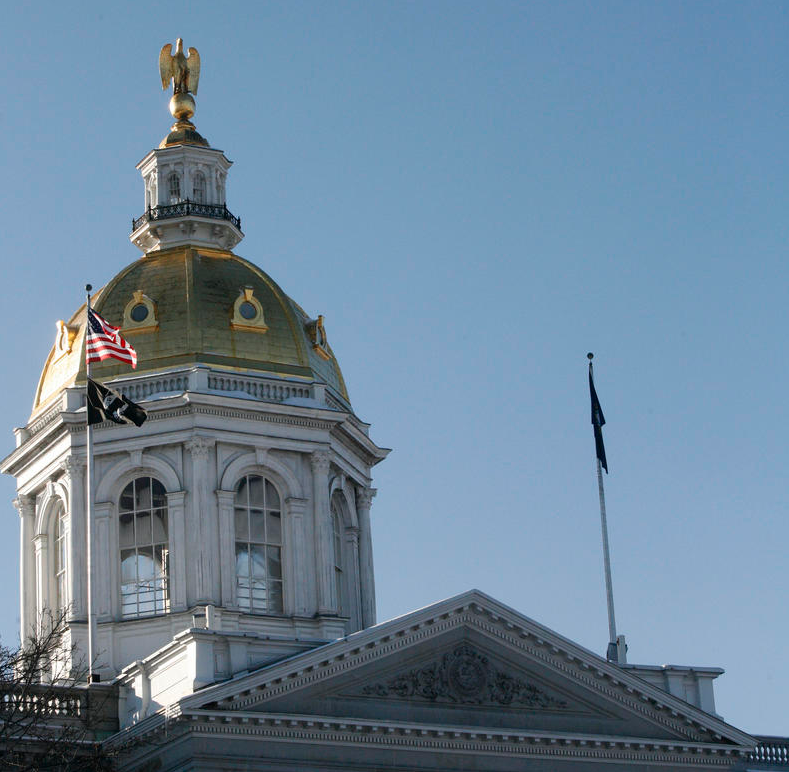Distant Dome is co-published by InDepthNH.org and Manchester Ink Link.
By GARRY RAYNO, Distant Dome
CONCORD – A new regime will grip the legislative gavel in two weeks and the seeds of the Democrats’ electoral tsunami will be planted in the state’s legislative and often rocky soil.
Democrats will face a number of significant issues needing immediate attention, but will they be bold enough to tackle the problems with new, creative solutions or employ a more timid approach hoping to build a more permanent majority for the future.
Do not be surprised if Democrats try to find a soft center the next two years, and that may be the better course for their party.

Garry Rayno
Democratic strategists know the real political prize lies in the next election in two years, when the winning party draws the new political boundaries for the two Congressional seats, the Executive Council, the Senate and the House.
Seven years ago Republicans had a super majority and were able to draw the boundaries at will as a gubernatorial veto was powerless in the face of their 75 percent majorities in the House and Senate.
The Republican gerrymandering was largely successful until this recent election, when the Democratic voting numbers blew huge holes in the once-thought-to-be water-tight political districts.
Democrats may have their chance in two years, but right now the new majority party will have to decide how best to address issues that will require major changes in how the state operates and ultimately its tax system.
New Hampshire is no longer one state, it is at least two and maybe three or four depending on how closely you want to delve into the statistics.
Some areas of New Hampshire have rebounded economically from the great recession and surpassed their old financial benchmarks. But other sections have seen little or no change since the great recession.
The North Country and other rural areas have not seen significant increases in employment, wages or other signs of prosperity.
In this New Hampshire, families are caught in a cycle of poverty, with substance abuse, lack of advancement and fraying nerves ripping apart the community’s fabric.
While state revenues continue to produce much more than budget writers’ estimates, there is little money going to programs that would help break the cycle such as additional money for education, particularly higher education to lower tuition, and workforce training programs that would help unskilled workers find new careers.
The golden triangle from Nashua to Concord to the Seacoast is thriving, unemployment is almost nonexistent, with home values skyrocketing and an economy constrained only by an aging workforce and few young people moving to the state.
Most of the prosperity in New Hampshire in is four counties: Hillsborough, Rockingham, Merrimack and Strafford, while the other six counties are essentially stagnant except for pockets around the Upper Valley, Plymouth, Conway and Keene.
Property taxes more than anything else keep this divide in place.
Poor rural towns and cities that lost their small manufacturing base have property tax rates that soared in the last decade, hurting low- to middle-income families and individuals, local schools and services, and making it nearly impossible to attract new businesses or young people.
Education funding is a ticking time bomb and lawmakers have made it worse over the past few legislative sessions not better by phasing out stabilization grants and adjusting the formula to address growing school enrollments in property wealthy communities.
Many of the communities that originally filed the Claremont education lawsuit are in worse shape now than they were when the suit was filed more than two decades ago.
Since the new funding scheme was first enacted, lawmakers have done little to improve it, instead they have made it more and more like it “used to be,” overly dependent on local property taxes, the very thing the state Supreme Court said was unconstitutional.
Also under the property tax category is the state’s current use system, which provides reduced property taxes on forests, land used for recreation or farming, and wetlands.
More than half the states land is under current use assessments which allows landowners to pay about 10 percent of what the fair market value property taxes would be.
The program was instituted in the 1970s when farms and large forest holdings were taxed as if they could be subdivided and sold as house lots. The idea was to conserve the lands for their current uses by discounting the property taxes.
The program is administered by a state board, is a state program, but is paid for by the property taxpayers in the communities where the parcels are located.
Some rural communities have 70 percent or more of their property under current use, which increases the property taxes for others.
Property taxes also have had to absorb reduction in state aid since the great recession when lawmakers decided to end municipal revenue sharing, school building aid and the 35 percent contribution to retirement costs for schools, municipalities and counties.
All that added significantly to the property tax burden.
As a package, property taxes are a huge issue to address and to make the system more equitable would require a wholesale change in the state’s tax structure, something the Democrats are not likely to want to tackle.
But without some plan to reduce the divide between property rich and property poor communities, many on the lower end will plunge into a death spiral without recovery.
Democrats talked about an economy that works for everyone during the campaign, and this issue is front and center to that notion.
Stopping the annual 4 percent reduction in education stabilization grants and automatic rate cuts for businesses taxes are likely Democratic targets, but more needs to be done.
Higher Education
The university and community college systems have never recovered from the reduction in state aid in the 2012-2013 budget. The GOP controlled legislature cut state aid to higher education in half.
The cut increased tuition at public colleges and universities that already were some of the highest in-state tuitions in the country and cemented New Hampshire to the bottom of the scale for higher education support.
It is no wonder New Hampshire students have the highest education loan debt in the country, which some experts believe will be the next big financial catastrophe.
The high cost of state colleges sends students to out-of-state institutions including private schools and means they are less likely to return to the state when they graduate.
Medicaid Expansion
Medicaid expansion was controversial under the Affordable Care Act, but now the insurance markets have stabilized and premiums have stopped skyrocketing.
And emergency rooms and health care providers are seeing fewer and fewer patients without insurance coverage which will help to if not keep premiums down for everyone at least slow the increases.
The program worked as intended, it reduced the number of uninsured and is touted as the state’s single biggest weapon against the opioid epidemic that has claimed more than a life a day for several years.
However, today the program is at the whim of the Trump administration, although a Democratically controlled US House will certainly put an end to attempts to repeal the ACA.
Democrats in New Hampshire are likely to try to remove some of the punitive measures passed in the last reauthorization of the program, like the work requirement and penalties for inappropriate use of expensive emergency rooms.
Human Services
The state’s mental health, development disability, child protection and elderly care systems need attention.
How much attention they receive will depend on what else is on the legislature’s plate, which appears to be full for the next two years.
Garry Rayno may be reached at garry.rayno@yahoo.com
Distant Dome by veteran journalist Garry Rayno explores a broader perspective on the State House and state happenings. Over his three-decade career, Rayno covered the NH State House for the New Hampshire Union Leader and Foster’s Daily Democrat. During his career, his coverage spanned the news spectrum, from local planning, school and select boards, to national issues such as electric industry deregulation and Presidential primaries. Rayno lives with his wife Carolyn in New London.





